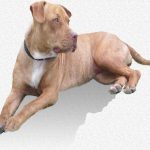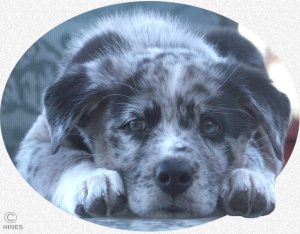Canine Bad Behavior – What To Do When Your Dog Is Aggressive
Particularly With Your Children
Ron Hines DVM PhD
 Read a more extensive article here
Read a more extensive article here
Counseling the owners of biting and aggressive dogs is one of the hardest tasks that veterinarians face. Your veterinarian’s training is in dealing with dogs and their personalities. But canine aggressiveness tendencies with family members is as much (or more) a human relationship problem than a canine problem. To solve it, you will have to make the relationship and your behavior change, your dog is usually the easier part. Dog situational behavior is quite predictable, but it is not very flexible. Human behavior is not as predictable, but in many situations, it is more flexible.
I love dogs. But my preference, my first choice, for families that discover that their dog has even the slightest aggressive tendencies is always that a new home be found for that dog. Anything else involves unpredictable risk to your child, your friend’s a child, a neighbor.
Tendencies toward aggressive behavior become more apparent as dogs near sexual maturity – at about 8-10 months of age. It often begins with the pet growling at a child over treats, food or toys. It can also begin as a spiral toward aggression during rough play with a child. In those situations, the dog might stares down children or assume an aggressive posture with its head down, tail extended, body in a crouched position and the hair of the neck and back slightly raised. Play fighting is a natural tendency of all puppies as they seek their place in the family “pack”. So one could easily confuse similar normal play activity with true aggression. A wagging tail and happy anticipatory head posture are my best clue that all is well. All packs have a strict hierarchy. Each dog knows exactly where it stands in its peck order. They sort that order out at a young age. Dogs will often challenge children in the family before they attempt to challenge the adults because children are smaller. Children are also more likely to make noisy quick approaches to the dog.
Do to a child’s smaller size; bites on the head and face are common. Encounters with aggressive dogs can leave bad memories in children – memories that they must deal with throughout their lives. Because play fighting and defending its place in the family peck order is a deep-seated emotional response, disciplining your dog or puppy after a bite occurs has little effect. Your puppy knows that you are upset with it. But it has great difficulty understanding why.
Aggressive biting can be confused with fear biting. Fear biting dogs are, by nature, shy, skittish dogs that have been forced into close proximity with a child. They bite in response to their fear or in response to pain inflicted on the dog by an unsupervised child.
Occasionally, protective breeds (e.g. chows, rottweilers, pit bulls etc.) bite neighborhood children engaged in horseplay and noisy excitement with your child in the mistaken belief that they are protecting one of their family.
There is a definite breed and bloodline association with aggressive and aloof tendencies in dogs. You will find more about that through the link at the top of this page. The puppies of a good family pet almost always carry the same set of “friendly” genes of their parents. Some folks choose a dog based on its AKC pedigree, its striking appearance, its presence in a movie you liked or the breed’s current trendiness. When you do that, the dog’s its suitability as a companion, a friend, a household member and a playmate for your children is always open to question. You can read some pointers I believe in when choosing a pet here, here and here.
Since dog fighting breeds “lock” onto the object they are biting and have abnormally powerful crushing jaw muscles, they are high on the list of the dogs causing severe wounds to children and other dogs. There are a lot of apologists for those breeds – including the ASPCA. But the fact that ~ 90% of fighting breeds are not dog or human-aggressive does not change the fact that ~10% are. Nor does it change injury statistics. Read those sad statistics here, here, here & here.
Top “problem breeds” change over time. As a breed becomes popular, dogs with unstable temperaments and poor general health tend to increase in number. Dog breeding is a business. Professional and non-professional breeders generate these psychologically and physically problematic dogs to meet increased buyer demand. When demand for a breed is high, potential buyers tend not to be as choosy in selecting a puppy. As the popularity of a breed declines, the frequency of health and personality problems tend to decline as well.
When an owner presents me with a situation where their dog has attacked or might attach their children, my first response (the safest for all concerned) is to find a new home for that dog with a family with no small children. It often only takes my reassurances that this is the right thing to do for everybody concerned to agree. I have been bitten by lots and lots of dogs. If I feel that this dog will be a potential threat to humans or other pets even if re-homed, I offer to put the dog down. If the owners plan to replace the dog, I suggest they wait a bit. I offer to screen potential puppies and the parents of the puppy for any signs of aggressive tendencies or ill health at no charge before purchase. They have already experienced enough sadness. Sometimes I will suggest a breeder whose lines I know to be psychologically stable and of good physical health. If they are set on keeping the dog they have, and I cannot talk them out of it, I explain to them again, as best I can, the risk to their children and the children of neighbors to make sure they are aware of the dangers involved. If they still have their heart set on the dog I suggest they find another veterinarian.
You really cannot predict which families will be successful in modifying a dog’s aggressive behavior. I usually provide them with the names and addresses of dog trainers I trust. I am sure your veterinarian can do the same for you if you ask. I let the dog owners know that the success rate in modifying aggressive behavior is less than fifty percent. Here are some of the things those dog handlers suggest they do and don’t do during this training:






Hopefully, some of these suggestions will reduce or eliminate canine bad behavior in your dog. What to do when your dog is aggressive is never an easy problem for a dog owner to face.
After a month or two has passed using these and other rules, many of them believe it is time to cautiously allow the child to pet or stroke the dog with the dog remaining muzzled. An adult’s hand should always be present on the dog’s shoulder during training. If the child is old enough, the dog should be leashed and the leash should be held taut and given to the child. The dog should be praised when it shows no evidence of aggression toward the child and ignored when it does. During the first six months, under no circumstances should the muzzle be removed from the dog when a child is present. If after six months, no signs of aggression occur, the muzzle can be removed from the dog when an adult has his or her hand surrounding the dog’s mouth and another hand on the dog’s shoulder. I strongly suggest you not attempt any of this without local professional assistance. It is also quite likely that whomever you choose will have different opinions than mine.
You are on the Vetspace animal health website
Visiting the products that you see displayed on this website help pay the cost of keeping these articles on the Internet.

